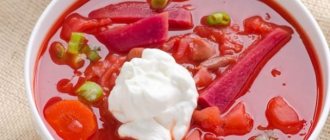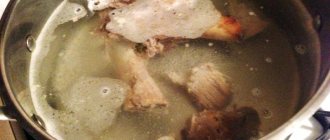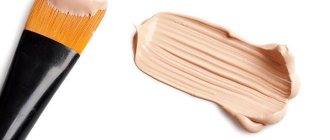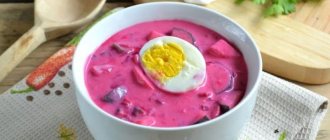Borsch! There is so much in this word... This dish is the dream of every man and the advantage of every woman. Each housewife has her own trump cards in preparing this soup. Its quality depends on many factors, including the choice of ingredients.
To make borscht rich, bright and tasty, you need to know certain subtleties and life hacks. Here we will get acquainted with the main ones.
How to cook red borscht so that the beets do not lose color. Nuances
This question may seem strange to some. Red beets - red borscht. Everything seems to be obvious. However, if you add vegetables to the soup incorrectly, the beets may lose color and the dish will not look very appetizing.
What should I do? After all, in theory, beets take longer to cook than all other vegetables and should go into the pan first?!
The answer is simple. Beets should not be added to the broth. It should be stewed in a frying pan along with carrots and onions. To fix the color, be sure to add a little vinegar or citric acid.
Meat broth for borscht should be rich. Therefore, you need to cook it on the bone for at least 2 hours. Next add potatoes and cabbage. Once the vegetables are cooked, the final step is to add the beetroot dressing. Cook the beets in the soup after adding them for no more than 5 minutes.
But there’s no need to rush here either. After removing from heat, the soup should sit for at least an hour. This way the beets will add color and flavor to the other ingredients.
So, we conclude:
- Beets need to be cooked separately in the form of borscht dressing, without adding a large amount of water;
- There you must add a tablespoon of vinegar or citric acid;
- After placing it in the soup, remove from heat for 5 minutes.
By adding finely chopped tomato to the beetroot dressing, you will get an even richer color and aroma!
Do you need vinegar in borscht?
Vinegar itself has a pungent and unpleasant odor, and tasting it is dangerous. But it is necessary to prepare borscht. Despite its characteristics, it helps to significantly improve the quality of the dish.
We recommend: Table vinegar: varieties, application
The fact is that when beets and cabbage are cooked together, one of them discolors the other. In a toga, the color of borscht turns out to be dirty orange. To prevent this from happening, use vinegar or citric acid. With the second option, you can overdo it with sourness, so the first is preferable.
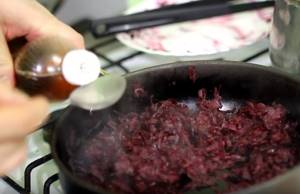
While cooking the broth, finely chopped beets are fried in a frying pan with the addition of vinegar. This will help preserve the taste and color of the vegetable, which will color the borscht the correct red color. Those who do not know this secret will never be able to get a beautiful dish like in the pictures in restaurants. Borscht with vinegar always looks better than without it. You just need to apply it correctly.
Borscht with fresh cabbage and beets according to the classic recipe (recipe 1)
This recipe is the most popular among experienced housewives. For beginners, we will look at it step by step.
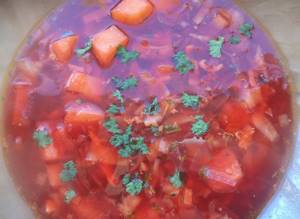
Ingredients for 3 liters of water:
- Beef on the bone 1kg
- Fresh cabbage 500g
- 4-5 potatoes
- 1 carrot
- 1 onion
- 2 tbsp tomato paste
- 2 cloves garlic
- salt
- spices for borscht
- 2 tbsp vinegar
Rinse the meat and place in a saucepan. Cook over low heat after boiling for an hour.
The readiness of beef is determined by the degree to which the meat separates from the bone.
While the broth is preparing, let's prepare the vegetables. Shred the cabbage using a vegetable slicer or knife. Cut the peeled potatoes into cubes. Peel the beets and carrots and cut into strips. Finely chop the onion.
Once the meat is cooked, you need to remove it and separate it from the bone. Then cut it into pieces.
To make the broth clear, skim off the foam that arises during the cooking process more often!
Add the chopped meat to the boiling broth.
Cabbage goes there too.
...and potatoes.
We send the beets with the addition of tomato paste to simmer in a frying pan hot with oil. After 10 minutes, add vinegar and wait a couple more minutes. Then remove from heat.
We also sauté carrots and onions until golden brown.
Add onions, carrots and beets to the soup.
Garlic is an important part of borscht! We add it, after chopping it with a knife, at the very end of cooking. It gives borscht that unique aroma and taste!
Remove the pan from the heat, let the borscht “rest” for 30 minutes and proceed to tasting with sour cream and herbs. Bon appetit!
Perfect borscht recipe
In order to prepare a modern and tasty version of borscht, you need to take:
- 500 g of meat (pork or beef on the bone);
- 4-5 medium sized potatoes;
- 1 medium beet;
- 1 small head of cabbage;
- 1 medium sized onion;
- 1 tomato;
- 1 medium sized carrot;
- 2-3 cloves of garlic;
- herbs and spices (bay leaf, black peppercorns, allspice).
All vegetables need to be washed and then peeled (the tomato can be left in the peel). Vinegar, washed herbs and spices are placed separately on the table.
Preparing Ingredients
After washing, vegetables need to be cut. The cabbage is finely chopped, the beets are chopped into strips, and the potatoes, tomatoes, and onions are cut into cubes. The carrots need to be grated on a medium grater. Separate the garlic into cloves and set aside. To prevent potatoes from turning black in the air, it is better to place them in a bowl of clean water.
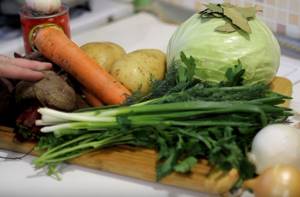
Carrots, onions and tomatoes are fried in a frying pan with sunflower oil until golden brown and soft. At this time, the beets are being cooked on another burner. It is lightly fried in vegetable oil with the addition of sugar and a teaspoon of vinegar (not to be confused with essence!). Vegetables should not be overdried, so you need to carefully monitor their readiness and remember to stir in time.
We recommend: Recipes for delicious marinades with vinegar for chanterelles
Cooking process
A medium-sized saucepan is enough for a small family. It is filled 2/3 with water. You should not pour more, as when adding vegetables the level of liquid will rise, and when boiling, it can spill over the edges and stain the stove. At this stage, add salt and put the meat to boil. It is placed in one piece to make the broth more tasty and rich.
While the broth is being prepared and the meat is cooking, you can do the vegetables. They are cut, then some are fried. The greens are also finely chopped. On average, the duration of cooking meat is 40 minutes with pork and 2 hours with beef. If the preparation of the ingredients has already been completed, but you cannot continue cooking the borscht, you can wash the dishes or clean the kitchen. This will save a lot of time and help maintain perfect cleanliness, which is no less important for the housewife than delicious food.
When the broth is ready, remove the meat to a clean, dry cutting board. It is divided into small pieces and returned back to the soup. Then add vegetables to the pan one by one:
- garlic (not chopped);
- cabbage (for 10 minutes);
- potatoes (another 10 minutes);
- turn off the heat, add overcooked onions, carrots and tomatoes and beets;
- add herbs and spices.
After all the ingredients are inside the pan, close it with a lid and leave the dish to steep for 2 hours. This is how it acquires aroma and does not lose color. It is not recommended to open and look at the soup, as this may interfere with the proper “ripening” of the borscht.
How to cook Ukrainian borscht with sauerkraut and meat (recipe 2)
Borscht is a multinational dish. Many countries are fighting for the title of homeland of this soup. However, it is Ukrainian borscht that is most famous throughout the world. What's special about it? Try it!
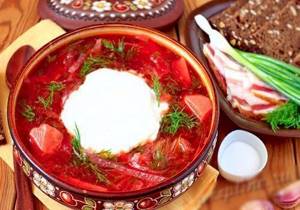
To prepare we will need:
- 2 small or one medium beets
- 1 carrot
- 6 medium potatoes
- 300g sauerkraut
- 1 large onion 4 cloves garlic
- 1kg beef on the bone
- 1 tbsp granulated sugar
- 1 tbsp apple cider vinegar
- salt, pepper, seasonings to taste.
Wash the meat and let it cook over low heat after boiling for 1-1.5 hours. Salt the broth. Don't forget to remove the foam using a slotted spoon. While the meat is cooking, prepare the vegetables. Peel the potatoes and chop into cubes.
Finely chop the onion, cut the beets and carrots into strips.
The onion is sent first for sautéing. Fry it until golden brown. Next, carrots are sent there, followed by beets.
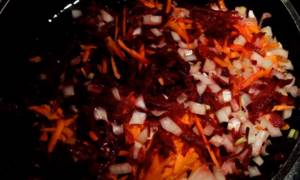
Simmer vegetables for no more than 10 minutes. Next add vinegar, sugar and finely chopped garlic.
Once the meat is ready, remove it and separate it from the bone. Crush with a fork. Now we put the meat back into the broth. Next will be sauerkraut and potatoes.
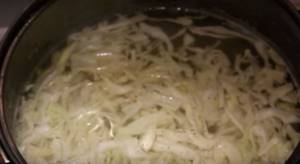
After 20 minutes, add vegetable dressing, spices to the borscht and simmer for 3-5 minutes.
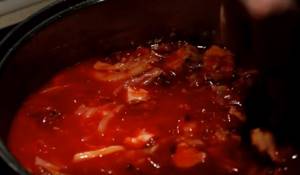
Ready borscht should sit for about an hour! Bon appetit!
Russians, Ukrainians and Poles have been arguing for a long time about whose national dish is borscht. However, they all agree on one thing: borscht should be red. Unfortunately, beets often lose color when cooked, and the dish ends up being paler than the cook would like. How to avoid this and maintain its rich red color?
Cooking borscht in winter from ready-made dressing without cabbage
Good afternoon, my reader. Have you ever heard anything about royal borscht? And I heard that this amazing soup is cooked using more than a hundred ingredients. Borscht is the most favorite first dish for many people. Each family cooks it according to its own recipe, using certain ingredients. The composition may differ qualitatively even in different regions.
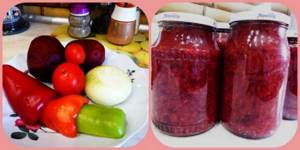
Dressing for borscht. The illustration for the article is used from the site golos.id
But no matter how much we love classic borscht, it takes a lot of time to cook it. The main task is to cook a lot of vegetables. But I have a little secret here. I make the vegetable dressing ahead of time, which makes working on my favorite dish a pleasure. This dressing does not contain cabbage. And so I cooked a rich broth, added some potatoes and cabbage. When the vegetables are almost cooked, I add my super dressing, and the aromatic borscht is ready. It is very convenient and also useful. In addition to the twists, this dressing can be frozen.
EVERYTHING I NEED FOR REFUELING
We take about 1 kg of tomatoes and 3 kg of beets, we also need 1 kg of carrots, 1 kg of onions and 1 kg of bell pepper. As additional ingredients, add 1 glass of 9% table vinegar, a glass of sugar, 2 tbsp. spoons of salt and vegetable oil about 500 ml.
COOKING VEGETABLES
First, let's prepare the beets. We choose only good vegetables; if there are spoiled areas, they must be carefully removed. We wash our product very thoroughly, then use a knife to peel it and grate it. To give beets a more beautiful appearance, you can use a grater to prepare Korean carrots. But whoever likes it.
Next, prepare the carrots. Wash, peel and grate or chop.
We prepare the pepper as follows: wash it, remove the insides and cut it into very thin strips.
Peel the onions, wash and cut into small pieces.
We select only ripe and whole tomatoes for our preparation. Next, we wash them, dry them and cut them into small slices.
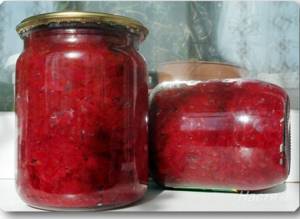
Dressing for borscht. The illustration for the article is used from the site koffkindom.ru
LET'S START COOKING
Pour oil into a heated frying pan. It is important here that the vegetable oil is odorless. Next, put the beets there and fry. Next, put it on low heat and simmer it for about half an hour. To prevent the beets from burning, you need to stir them constantly.
As soon as the beets are ready, add all the other vegetables and, stirring them constantly, simmer. At the same stage of cooking, we need to add sugar, salt and vinegar. Our entire vegetable mixture should simmer for about an hour. It is important not to overdo it over time, as the dressing can turn into mush.
We had to prepare the twist jars and lids in advance. All this must be sterilized. Now we put our prepared dressing there and roll up the lids. We turn the jars over and leave them on the floor, covered with a warm blanket. A day later, our jars can be put away in the pantry.
The most delicious and vitamin-rich borscht dressing is ready for you. Now winter is not scary for you!
Why does the soup turn pale?
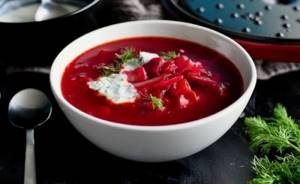
- Long-term heat treatment. The pigment is not thermally stable, and therefore, during prolonged cooking or frying, it disintegrates.
- Alkaline environment. It is provided by a number of products - beans, cabbage or carrots. Borscht without cabbage is the same nonsense as without beets.
Hence the conclusion: in order for the borscht to retain its bright red color, the beets cannot be digested in it, and contact with alkali must be avoided for a longer time. Now let's see how this all looks in practice.
All recommendations given below are indicative only. There is no single canonical recipe, for violation of which a heretic is excommunicated from cooking.
How to cook bright red soup?
Correct cutting
Preparing beets for adding to borscht dressing involves two mutually exclusive points:
- The smaller the pieces , the more juice. The more juice, the tastier the borscht... but the less red it is, because the juice, unlike beet pieces, definitely has time to both thermally decompose and react with the alkaline environment.
- The larger the pieces, the more juice remains inside, the richer the red color - but the borscht turns out less tasty.
Other useful tips
There are some additional tricks to help preserve the color of borscht when cooking:
- When frying, you can add a little (literally a couple of pinches) of sugar and flour. This mixture will caramelize the beet chunks and keep the juice from leaking too much. However, in this case you need to add it literally grain by grain - and stir the frying often, otherwise the taste and smell of burnt sugar will kill the entire dish.
- In addition to a piece of raw beets, you can add beet juice to the borscht. To do this, grind raw beets, squeeze out the juice through cheesecloth or simply with your fingers. The beets themselves are sauteed with carrots and tomato paste - but the collected juice is poured into the pan literally a couple of minutes before they are ready.
- Finally, the color of borscht very much depends on the color of the beets. If you take sugar or hybrid beets instead of red beets, no matter how hard you try, you won’t get a bright color: both sugar beets and their random hybrids with red beets produce only pale pink, yellowish or colorless juice. But good varieties of table beets (such as Kuban borscht) have a bright and rich color.
How to preserve beetroot color after heat treatment?

Often bright red borscht turns pale pink or even brown on the second day. How to avoid this? Let's look at how to preserve the color of soup not only during cooking, but also after it.
- When heating the borscht, there is no need to boil it. It's better to heat a small portion in a small saucepan than to boil the entire stock.
- As a last resort, you can bring the pan to a boil and immediately turn off the heat. In this case, the dish will be disinfected from accidentally introduced microbes from the air - but will retain its color.
Many people believe that borscht becomes truly tasty only on the second day, when it has steeped. Therefore, it is important not to overheat it, so that not only the taste, but also the appearance is good.
How to correct cooking mistakes?
If, despite all efforts, it was not possible to get bright red borscht and it has lost its brightness, you can try to take emergency measures:
- Add a couple of tablespoons of tomato paste to the already prepared borscht, stir well and bring to a boil, but do not boil. Then let it brew for at least half an hour. Often the paste corrects the color of the broth.
- Additionally, boil another small beetroot, then grate it on a coarse grater, add it to the hot, but not boiling borscht and also let it brew.
Borsch color

Photo from the site https://odsgomel.org/rus My borscht also turns out differently every time. I make broth for it from all types of meat - sometimes I don’t disdain chicken, but the most delicious borscht is made from lamb. And during Lent I cook it vegetarian. I put sauerkraut or fresh cabbage. Sometimes I even mix sour and fresh. I’m also experimenting with beets. I usually add boiled one. Sometimes I sauté fresh grated on a coarse grater thoroughly in a frying pan.
The only problem is that the color of my borscht never turned out rich and beetroot-like. All the natural beet coloring dissolves in the broth and the dish has a reddish or even pink appearance. I've tried many recipes. I looked on the Internet and in cookbooks. I added vinegar to the sauté and lemon juice, but still, I couldn’t achieve the “correct” beetroot color. The only way is to add boiled grated beets to the plate immediately before serving. But this is not always convenient. And then a random conversation about tomato paste gave me an idea. My sister heard from an experienced chef that tomato paste should be fried a little in vegetable oil before adding to dishes. “Why?” asked my sister. And I received a short answer: “It tastes better this way.”
I remembered the advice and in the next borscht I decided to test the innovation. Added fresh cabbage and 1 potato to the broth. While the vegetables were cooking, I prepared the dressing. I poured vegetable oil into a frying pan, put boiled beets grated on a coarse grater, added tomato paste, finely chopped tomatoes, chopped onions, and grated carrots. Simmer the vegetable mixture over medium heat, covered, for about 15 minutes, adding broth from the pan and a little more vegetable oil. Place the prepared dressing in a saucepan with boiling vegetables, bring to a boil, add bay leaf and herbs. And the miracle happened! Although the color is still not beetroot, it is very rich and thick. It was a sin not to remove such borscht!
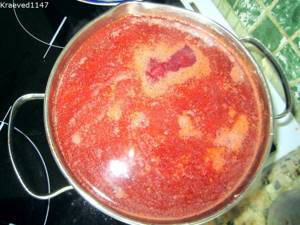
It was necessary to photograph the gas station, but who knew what the result would be? Next time I’ll be sure to record the whole process and add it to the article. This borscht is very good when freshly cooked! Tomorrow it will be even tastier - it’s not for nothing that V.A. Gilyarovsky wrote that Testov certainly served “day-old” cabbage soup. And don't forget about sour cream!
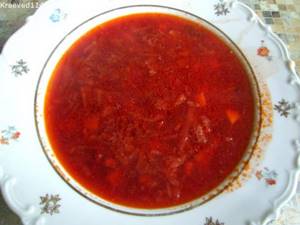
Borscht color. This is how he should be. I forgot the sour cream.
